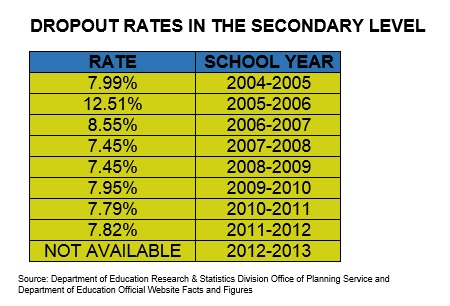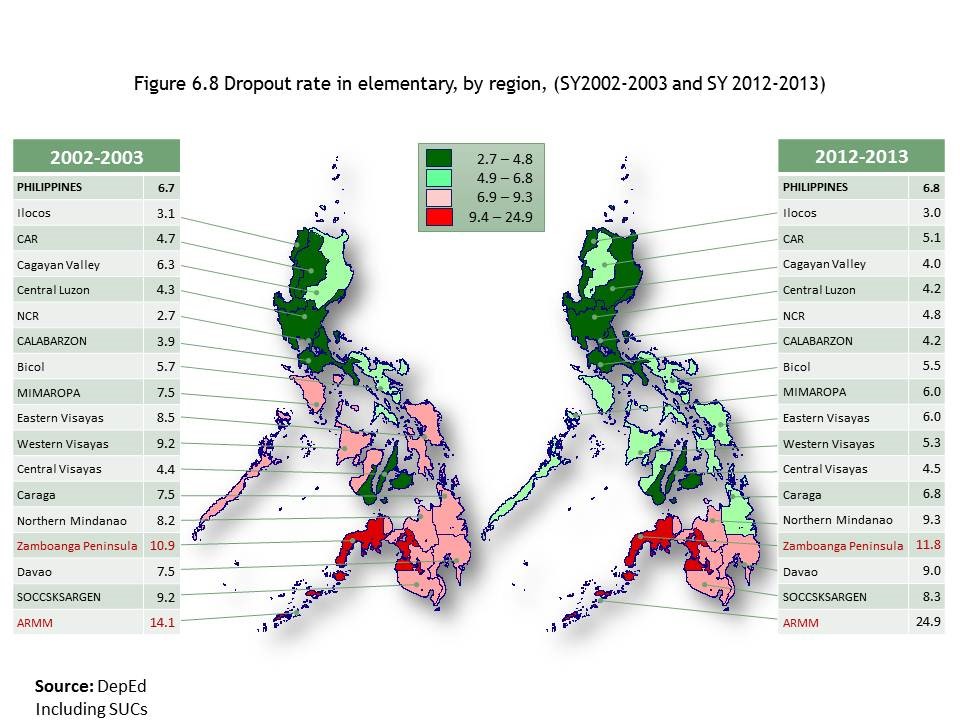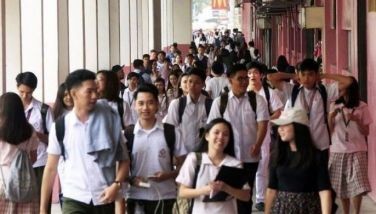Phl dropout rates rising since 2007
MANILA, Philippines - When he was 14, Andren Yoshino decided to stop studying because of the hassles he had to face when traveling to school.
“The distance I had to travel was quite far, from Bulacan to Legarda. I needed to wake up at 3 a.m. every day so that I won’t be late,†Yoshino said.
Yoshino also felt that he was alone since his mother started to work in Japan.
“Even if there is no problem in terms of financial support, the moral support of a parent who can guide you anytime is a different thing,†he said.
The case of high school dropout Cris (not his real name) was different. He simply does not have the drive to study.
“I was not interested to study. My mom insisted that I continue going to school but I didn’t listen to her advice,†he said.
Andren and Cris are just two of the thousands of students who left school in a country that is still struggling to make education a universal right. And despite state-funded efforts to improve the quality of education, the government is still grappling with a high dropout rate.
Rising
Available figures from the Department of Education (DepEd) show that there has been no significant movement in dropout rates among elementary and high school students in the last five years.
The elementary dropout rate never got past the 6 percent level since 2008 while that of the secondary level remained within the 7 percent territory since 2007.
The figure fluctuated five years earlier, with the secondary dropout rate reaching as high as 12.51 percent while that of elementary level climbing to a peak of 7.33 percent.


However, dropout rates in both levels have been rising, albeit slowly, since 2007.
From 5.99 percent in school year 2007-2008, the dropout rate went up gradually until it reached 6.81 in school year 2012-2013. The same trend can be observed for the secondary level dropout rate, which ranged from 7.45 percent in school year 2007-2008 to 7.82 percent in school year 2011-2012.
Improving?
The DepEd claimed that the figures actually reflect an improvement given a rising enrollment rate.
“If you’re going to round it off, the dropout rates are flat,†Education Assistant Secretary for Planning Jesus Mateo told philstar.com in an interview.
“That’s good because your enrollment rates are increasing, but your (dropout) rates remain the same,†he added.

Education Assistant Secretary for Programs and Projects Lorna Dino said the increase in enrolment is “a positive performance indicator†because more school-age children and youth are in school. She, nevertheless, acknowledged that a zero drop-out rate is the most ideal target.
“Any number higher than this is significant because it still represents learners who are pushed out of the schools,†Dino said.
Ronald Paguta, chairman of the University of Santo Tomas business economics department, said a minimal change in figures could translate to hundreds or thousands of students.
“The six percent could account for a big number of dropouts. If the Philippines has ten million students, that six percent would mean 600, 000 students who dropped out of school,†Paguta said.
DepEd figures for 2013 showed that a total of 126,368 public school students have dropped out of school in the elementary level while 236, 222 others have discontinued their studies in the secondary level.
Dino said failure to complete basic education might result in illiteracy, poor learning skills, less opportunity to acquire better jobs or acquire higher education and less opportunity to become entrepreneurs.
Why they quit school
Mateo said there are factors affecting dropout rates that are beyond their control. He said these include lack of interest among students, distractions and disasters.
“In Mindanao, especially in areas frequently affected by conflict, our agency cannot control conflict but this is one of the major reasons why they are dropping out,†Mateo said.

“Another point is the recent calamity ‘Yolanda.’ Many dropped out in Region 8 (Eastern Visayas). Others went to NCR (National Capital Region), others went to Region 6 (Western Visayas) or 7 (Central Visayas).â€
Dino said migration or change of residence, malnutrition, sickness and the distance between the school and the students’ homes also play a role.
In one of his privilege speeches, Kabataan party-list Rep. Raymond Palatino blamed poverty and government inaction for the dropouts, saying many families could not finance their children’s auxiliary school needs.
Rowell Rosales, a high school teacher at the La Salle University Greenhills, believes the government cannot be totally blamed for the persistently high dropout rates.
“For me, it is the family that has the sole responsibility with respect to dropout cases,†Rosales said, adding that most cases of dropouts are related to students who have behavioral problems.
Solutions
Officials said measures are underway to minimize the dropout rates in the country.
National Economic and Development Authority Director Erlinda Capones said the DepEd has implemented the Dropout Reduction Program (DORP), which offers alternative modes of education for students at risk of dropping out.
Under the program, DepEd determines the reasons why students leave school through interviews. DORP also allows working students and out-of-school-youth to continue their studies through the Open High School Program, which uses specialized modules.
Other programs targeting the dropout problem are Project EASE (Effective Alternative Secondary Education), which allows absentees to catch up on their lessons through innovative learning tools; and Abot Alam, which aims to unite the out-of-school youth with their communities.
Capones claimed the K to 12 program, which has been criticized for supposedly posing additional burden to parents, could also address the dropouts.
The program makes it a requirement to enroll children in kindergarten before they can start six years of primary education. It also added two years to the four year high school curriculum.
“The curricular reforms under the K to 12 Program also seeks to address the dropout problem because the decongested curriculum under K to 12 will allow mastery of competencies and enable students to better cope with the lessons,†she said.
“One reason for dropping out is because students cannot cope with schoolwork.â€
Mateo believes the dropout problem is a multi-dimensional issue that requires everybody’s cooperation.
“We can only do so much… The whole community, the whole society should work together,†he said.
- Latest
- Trending
























